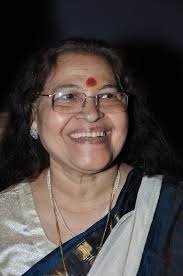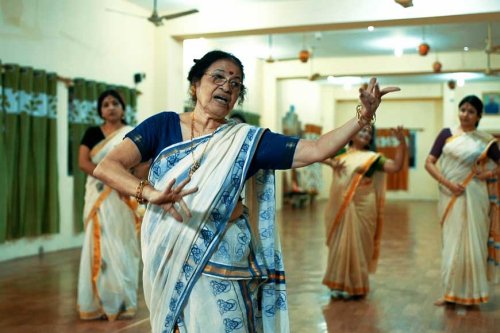
|
 |

|
 |
Kalamandalam Thankamani Kutty turns 80 - Tapati Chowdurie e-mail: tapatichow@yahoo.co.in December 7, 2020 Kolkata based dance guru Dr. Kalamandalam Thankamani Kutty recently celebrated her 80th birthday. Here is an excerpt from an informal conversation with her. How have you fulfilled your duty of carrying on the parampara of your learnt arts? Parampara is unique to Bharat, where learning of our ancient art is handed down from generation to generation. It is the utmost duty of a guru to teach his disciples, his learnt art so that he may in turn do likewise. This is the concept, which is popularly known as guru-shishya parampara. Change is inevitable and one must conform to the call of the soil. By saying this, I mean that since I am in Bengal and have lived my entire work life here, it was my labour of love that I needed to be a part of the land where people are artistic and emotional by nature. However one has to be rooted to the learning imbibed to bring about any changes. Between 1952 to 1956, I was learning Mohiniattam and Bharatanatyam in Kerala Kalamandalam. There I had to learn the allied arts of music, mridangam, taalam and the languages. Our classes started from 5am and continued till 8pm in the evening. We practically lived and breathed dance and music. In today's changed scenario, I have trained my students with utmost sincerity and have put in my best to bring out the best in them.  What has been your special contribution in your area of learning? I have composed many Thillanas, Varnams, Javalis and Bhajans. I have choreographed Dasavataram from Jayadeva's immortal Geeta Govinda and Vallabhacharya's Madhurashtakam among others. My compositions Trahi and Sangeetam have been received well by the discerning public. My syllabus has always had the flexibility of matching the students' capabilities. The pieces I catered to urban students and students coming from a rural background have been different; thereby I have managed to create comfort zones for each of them. I have created a taste in the rasikas for the rich cultural heritage of our country. Today the name Bharatanatyam and Mohiniattam are household names in Bengal. I have given serious students who want to be teachers, a teacher training course too. Many of them have their own institutions around the globe. What kind of research do you do before embarking on a new work? While working on projects on the sons of the soil such as Swami Vivekananda, Kazi Nazrul Islam and Rabindranath Tagore, I first try to understand the sahitya as well as the philosophy they have preached. Dance dramas require special treatment, which I need to pay attention to. At every juncture opinion of scholars and experts are taken to make the production authentic. Into how many categories would you divide your work from the 60s to 2020? I have been working since 1968. Of course, there have been many natural changes in my choreographies that have occurred with my experience and maturity. The 70s was the time when I would present a variety of pieces from Bharatanatyam and Mohiniattam margam. In the 80s, I ventured into group choreographies. In the 90s I worked on the epics in classical format and gradually I started choreographing the dance dramas of Rabindranath Tagore, which was rather challenging because of the variety of characters coming from different strata of society requiring both natyadharmi and lokadharmi pieces. With my background of classical dance I had to burn my midnight oil and device lokadharmi movements for the portrayal of certain characters - like in Chitrangada, I had to choreograph dances for an attacking gang of dacoits. From 2000, I started concentrating on experimental work to choreograph pieces on Rabindra Sangeet.  How is your style of Bharatanatyam different from the Kalakshetra style and Ramaiah Pillai's style? Thanjavur, Kumbakonam, Vazhuvur and Meenakshi Sundaram Pillai's sampradaayams roughly comprise the different schools of Bharatanatyam dance styles. Though I was trained in the Thanjavur sampradaayam, I have from time to time, imbibed the aesthetics of other styles as well. I have adopted from the aesthetics of Vazhuvur Ramaiah Pillai and Kalakshetra schools styles to my advantage. Who are some of the pan Indian dancers who you think have maintained their aesthetics? If you are asking about Bharatanatyam dancers, then I have many performer cum teacher in my list. I venerate dancers like Balasaraswati, Kumari Kamala, Shanta Rao, Yamini Krishnamurti, Chitra Visweswaran, C.V. Chandrasekhar, V.P. Dhananjayan and Shanta Dhananjayan. I have watched their performances and liked them immensely. They have certainly maintained the aesthetics of the form. Did you have your fair share of problems in running your school, besides dealing with fond parents eager to see their daughters on stage soon after joining your classes? In my production Ramayana, Rama had only Nila the monkey Chieftain, enacted by my son Suku, helping Rama against his battle with Sugriva. That was the first and last time I was choreographing Ramayana because Ramayana has one Sita and a battalion of monkeys, but I needed a version that had many Sitas and no monkey - everyone wanted to do Sita's role, and no one wanted to do the monkey role! What would your message be for the generation next? To pursue anything they have to learn seriously and honestly and try to delve deep into the subject without any compromise. Dancers have to relate to the Arts, have faith in their work. To mesmerize others, they have to satisfy themselves first and be in a happy zone. To reach the pinnacle of glory they need to be under a guru with a vision and make devotion-dedication-discipline their guiding star. How would you want to be remembered? As a god fearing, honest, lovable, friendly, helpful person whose first priority was her students. A person, whose life's motto has been to guide those under her tutelage. A person who has never been hesitant to point out the right and wrong, who was ready to adapt to the changing times and who was always available for all her students. I would like to be remembered as a dance guru or a mentor, a practitioner of Indian classical dance who had the opportunity to guide a few generations of students to become dancers worth their salt.  Tapati Chowdurie trained under Guru Gopinath in Madras and was briefly with International Centre for Kathakali in New Delhi. Presently, she is a freelance writer on the performing arts. Comments * At the outset, we must thank Narthaki and Tapati Chowdhurie for such a wonderful interview in such a prestigious magazine. Dr. Thankamani Kutty has always said that she does not believe in "borrowing" from any other dance style but she prefers to "adopt" from other dance styles as well as many dance productions she gets influenced to. - Kalamandalam Calcutta (Dec 14, 2020) * I would say that I have consciously and unconsciously tried to emulate her in not just dance, but all areas of life. Auntie is unique and very precious to this world. - Indrani (Dec 8, 2020) Post your comments Please provide your name and email id when you use the Anonymous / blog profiles to post a comment. All appropriate comments posted with name and email id in the blog will be featured in the site. |